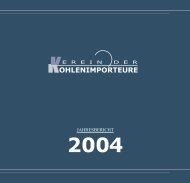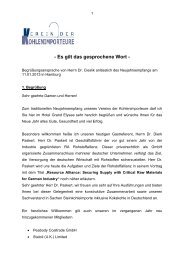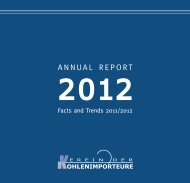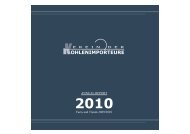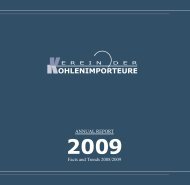Annual Report 2010 - Verein der Kohlenimporteure eV
Annual Report 2010 - Verein der Kohlenimporteure eV
Annual Report 2010 - Verein der Kohlenimporteure eV
Create successful ePaper yourself
Turn your PDF publications into a flip-book with our unique Google optimized e-Paper software.
Infrastructure<br />
China’s infrastructure is steadily being expanded,<br />
strongly supported by the economic stimulus<br />
programme that started in 2009. Shenhua Group<br />
alone announced that it wanted to invest about US$<br />
5.3 billion in 2011, of which 40% would be spent<br />
on railway and port infrastructure. Chinese railways<br />
transported about 1.5 billion tonnes of coal in <strong>2010</strong>,<br />
almost 45% of total output. Expansion of the railway<br />
system is a great challenge for China because more and<br />
more coal must be transported from the north and west<br />
to the consumer centres in the south. China’s largest<br />
coal port, Quinhuangdao, handled 224 Mt of coal in<br />
<strong>2010</strong>, overstretched beyond its capacity. Plans also<br />
exist to expand the capacity of the ports of Huanghua<br />
and Tianjin.<br />
Imports/Exports<br />
China’s import-export development in <strong>2010</strong> had a major<br />
effect on quantities and prices on the international hard<br />
coal market. China’s change from being a net exporter<br />
to a net importer of coal, first observed in 2009,<br />
continued.<br />
Chinese Import/Export Development<br />
Change<br />
2009 <strong>2010</strong> 2009/<strong>2010</strong><br />
Mt Mt<br />
Mt<br />
Steam Coal Imports<br />
92* 119*<br />
+ 27<br />
Coking Coal Imports<br />
35 47<br />
+ 12<br />
Total Imports 127 166 + 39<br />
Steam Coal Exports<br />
22* 18*<br />
- 4<br />
Coking Coal/Coke Exports 1 4<br />
+ 3<br />
Total Exports<br />
<br />
LB-T37<br />
23 22 - 1<br />
Additional imports of 39 Mt and 4 Mt less exports of<br />
steam coal influenced the world market by a net amount<br />
of 43 Mt. This provided some compensation to coal<br />
exporting countries for the weak demand for steam coal<br />
and coking coal in the Atlantic region during the first<br />
half of <strong>2010</strong>.<br />
China’s total exports declined by 1 Mt to 22 Mt in <strong>2010</strong>.<br />
Exports of steam coal fell further, by 4 Mt to 18 Mt<br />
(including anthracite), while exports of coking coal<br />
changed only minimally.<br />
The export of coke increased from 0.5 Mt in 2009 to<br />
3.3 Mt in <strong>2010</strong>. The largest customers for the sharply<br />
reduced exports of steam coal and coking coal were<br />
<br />
Mt).<br />
Chinese Coal Exports by Quality<br />
2008<br />
Mt<br />
2009<br />
Mt<br />
<strong>2010</strong><br />
Mt<br />
Steam Coal 35.9 18.5 13.6<br />
Coking Coal 3.5 0.6 1.1<br />
Anthracite 6.1 3.2 4.2<br />
Total 45.5 22.3 18.9<br />
Coke<br />
LB-T38<br />
12.1 0.5 3.3<br />
China’s 31% increase in coal imports strongly<br />
influenced the world market. It was covered mainly<br />
<br />
<br />
Vietnam supplied 18 Mt of anthracite, largely to<br />
south-west China, and coal was also imported from<br />
the Atlantic region, including from the USA, Canada,<br />
Colombia and South Africa.<br />
83



